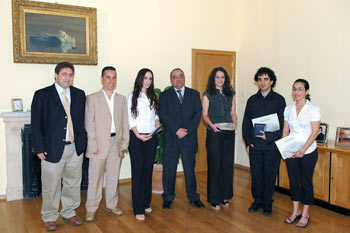 Minister
Austin Gatt congratulated the Maltese team, of four students reading a
Bachelor of Science in IT honours degree, who came first in the East
Mediterranean regional Microsoft Imagine Cup competition 2007. Minister
Austin Gatt congratulated the Maltese team, of four students reading a
Bachelor of Science in IT honours degree, who came first in the East
Mediterranean regional Microsoft Imagine Cup competition 2007.
This
year’s team consists of four students reading a Bachelor of Science in
Information Technology (BSc IT) honours degree at third-year level,
specialising in the Computer Science and Artificial Intelligence (CSAI)
stream: Abigail Cauchi, Jennifer Fenech, Karl Fenech, and Luana
Micallef.
The participation in this competition is possible thanks to the Ministry for Investment, Industry and IT and Microsoft.
Following
this successful result, the students shall now be representing Malta in
the worldwide finals, scheduled to take place next August in Seoul,
South Korea. The Maltese team will compete with teams hailing from all
over the world. This is the second time that Malta places first in the
regional competition: last year a team of Maltese University students
placed first and travelled to India to participate in the worldwide
competition finals.
Imagine
Cup is an annual competition organised by Microsoft Corporation which
brings together young technologists worldwide to help resolve some of
the world’s toughest challenges. The software design
competition invites teams of up to four students from post-secondary
and tertiary educational institutions to submit their ideas in the form
of software solutions which address a specified theme. The Imagine Cup
competition commenced four years ago, and already more than 100,000
students from over 100 countries have participated.
Imagine
Cup 2007 is themed “Imagine a world where technology enables a better
education for all.” Participants were encouraged to use cutting-edge
technologies to come up with creative and innovative solutions for
improving educational opportunities for students around the world. This
mission is closely aligned with the Education For All (EFA) goals,
established by the United Nations Educational, Scientific and Cultural
Organization (UNESCO), which aims to “universalize primary education
and massively reduce illiteracy by the end of the decade.”
About the Project
Microsoft
recently introduced the Windows MultiPoint, a powerful technology
enabling multiple users to simultaneously and interactively share a
single computer using multiple mice and cursors identifiable by their
colour. MultiPoint helps shift the student from passive to active
learning, and the collaborative environment adds a whole new layer of
value to the computer in the classroom. The solution put forth by the
Maltese team is a fully-integrated MultiPoint system which is easy to
use, extensible, and most importantly, promotes a constructive pedagogy
and an intuitive way for teachers to make their lessons more
interactive, interesting and collaborative. Through the system,
students may be assessed whilst engaging in educational software
activities, enhancing their motivation. State-commissioned or
commercial developers may upload new applications which would be
seamlessly incorporated into the system and immediately available
within all classrooms.
The
system was devised following extensive research on learning paradigms,
including collaboration and the use of games within the educational
context, and is meant as a motivational prototype
for eventual deployment in real-life scenarios. Seamlessly integrated,
it binds all stakeholders (developers, administration, teachers, and
students) in their respective roles, amplifying the dissemination of
knowledge and providing enhanced educational opportunities for all. The
system also enables an innovative edge, giving unbounded opportunities
for the development of applications to best meet the local demands. All
this is captured in the title chosen for the project: KIKI short for a
Key to the Integration of Knowledge and Innovation.
The
team tested the system with the help of a primary state school using a
class of thirty students. The setup consisted of eight computers for
the students, each having three to four mice connected, and the
teacher’s computer. The competitive aspect brought about by this fresh
pedagogy was very successful at keeping the students engaged in a
typical lesson. The students were absorbed throughout the lesson, with
a constant display of enthusiasm towards the new system. Meanwhile, the
teacher found it easier to control her class and, with the help of the
real-time progress-monitoring system, had more control on the
performance of each student.
19.06.07 |